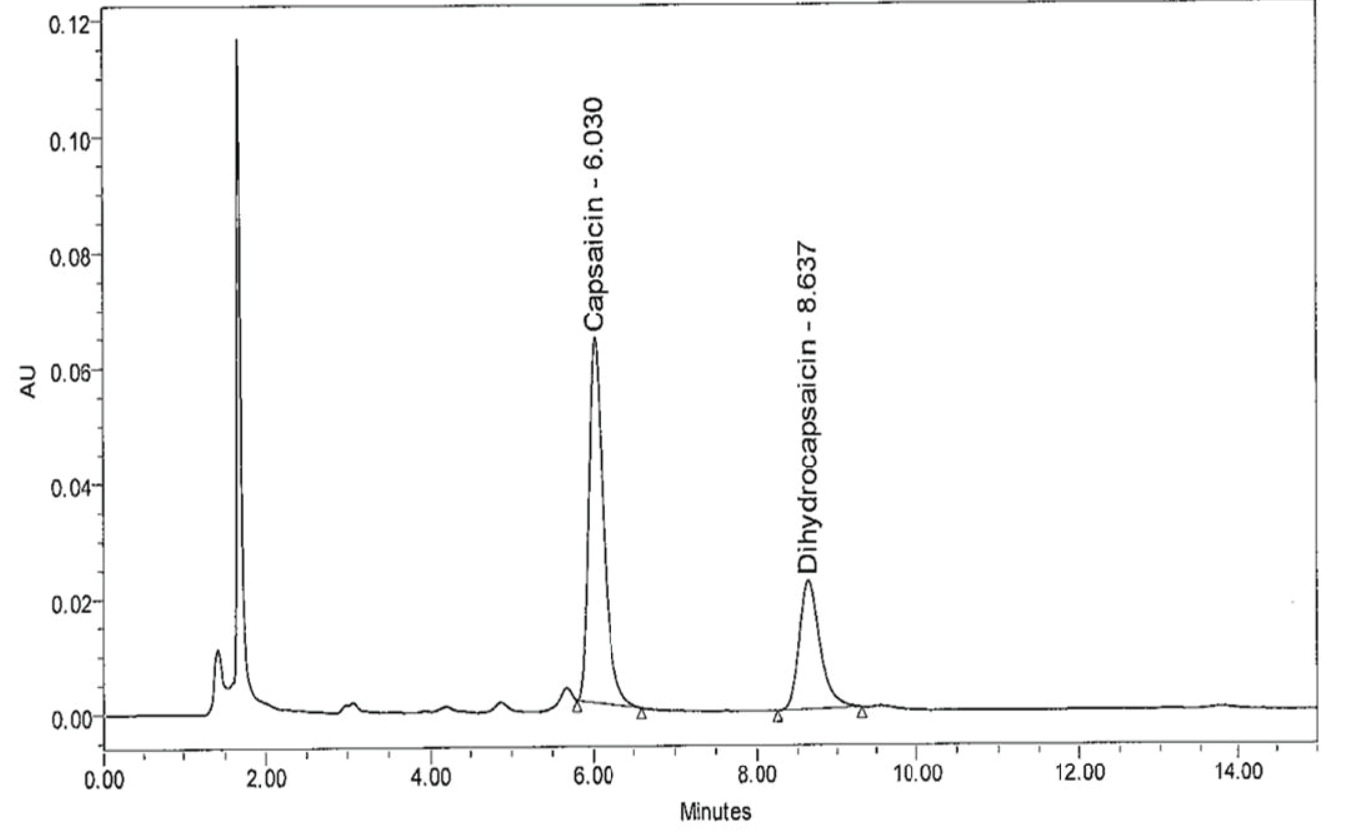Physicochemical properties and capsicinoids content of Thai chili cultivars used in southern sour curry paste (Kaeng Som)
DOI:
https://doi.org/10.60136/bas.v11.2022.140Keywords:
Capsaicinoids, Pungency level, Scoville heat units, Chili cultivars, Sour curry pasteAbstract
Chili is a spice that is regularly used in food production to enhance the color, taste, and flavor all over the world. The pungency of chili originated from capsaicinoids. Therefore, this research aims to analyzed the physical and chemical properties of Thai chili cultivars used in Southern Kaeng Som. Five cultivars of Thai chilies (8 samples) were collected, including KHO.1P, KHO.2P, KAR.2R, JIN.2K, YOD.1N, YOD.2N, KEN.2R and KEN.2P. In order to find their quality, the physical appearance, physical properties were analyzed. The physical analysis showed that the color of fresh chili samples was found as red to yellow-green. The chemical analysis showed that their the total soluble solid (TSS), pH, total acidity (TA) and maturity index were found in the range of 6.0-13.0 °Brix, 5.09-5.60, 0.11-0.18% and 35.3-86.7, respectively. Moreover, their capsaicinoids were found in the range of 3,048.64- 6,832.56 mg/kg dry weight. The pungency of chili samples was classified to very highly pungent (>80,000 SHU): YOD.1N > KAR.2R > KEN.2P > YOD.2N > KHO.1P, and highly pungent (25,000 - 70,000 SHU): KEN.2R > KHO.2P > JIN.2K, respectively. Furthermore, their capsaicinoids and pungency depended on cultivars, agricultural area, growing conditions, and maturity stage.
References
ทัตดาว ภาษีผล ปนัดดา มาลาศรี และสุภาวิตา ศรีลำไย. สมบัติทางเคมีกายภาพของสารสกัดจากพริก ชี้ฟ้าที่ใช้ตัวทำละลายที่ไม่ใช่น้ำ. มหาสารคาม: ภาควิชาเทคโนโลยีการอาหารและโภชนศาสตร์ คณะเทคโนโลยี มหาวิทยาลัยมหาสารคาม, 2560.
นนทวัฒน์ ปรีดาภัทรพงษ์. การผลิตโอลีโอเรซินและสีน้ำมันจากพริก. วิทยานิพนธ์ปริญญาวิทยาศาสตรมหาบัณฑิต มหาวิทยาลัยเกษตรศาสตร์, 2537.
ขวัญชัย ชอบสำราญ และคณะ. ผลของแสงสว่างที่มีต่อการเปลี่ยนสีของไส้กรอกหมูในระหว่างการจัดเก็บ. การประชุมทางวิชาการของมหาวิทยาลัยเกษตรศาสตร์ครั้งที่ 54 มหาวิทยาลัยเกษตรศาสตร์. 2559, 319-326.
นิจฉรา ทูลธรรม. เค้าโครงความเผ็ดและกลิ่นฉุนของพริกแห้ง. วิทยานิพนธ์ปริญญาปรัชญาดุษฎีบัณฑิต มหาวิทยาลัยสงขลานครินทร์, 2557.
AOAC.Office Method of Analysis.20th ed.Association of Official Analytical Chemists. VA.: U.S.A., 2016.
สายชล เกตุษา และคณะ. การเจริญเติบโต การเปลี่ยนแปลงทางชีวเคมี และดัชนีการเก็บเกี่ยวของผลมะม่วงพันธุ์ ทองคำ. 2534, 25 (4), 391-399.
พันธุ์ทิพย์ ปานกลาง.ลักษณะทางกายภาพ ปริมาณ oleoresinและความเผ็ดของผลพริก. นครปฐม : ภาควิชาพืชสวนคณะเกษตร มหาวิทยาลัยเกษตรศาสตร์, 2547.
ประเสริฐ ประภานภสินธุ์. เปรียบเทียบเทคนิคการสกัดสารแคปไซซินในพริกพันธุ์ต่าง ๆ. วิทยานิพนธ์ปริญญามหาบัณฑิต มหาวิทยาลัยเกษตรศาสตร์, 2544.
KRAIKRUAN, W., S. SUKPRAKARN, O. MONGKOLPORN, and S.WASEE. Capsaicin and Dihydrocapsaicin Contents of Thai Chili Cultivars. Kasetsart Journal (Natural Science). 2008. 42, 611–616
SRICHAROEN, P., N. LAMAIPHAN, P. PATTHAWARO, N. LIMCHOOWONG, S. TECHAWONGSTIEN , and S. CHANTHAI. Phytochemicals in Capsicum oleoresin fromdifferent varieties of hot chilli peppers with theirantidiabetic and antioxidantactivities due to some phenolic compounds. Ultrasonics Sonochemistry. 2017, 38, 629–639.
วสุ อมฤตสุทธิ์. การศึกษาสถานภาพการผลิต และความสัมพันธุ์ของสิ่งแวดล้อมที่มีผลต่อผลผลิต คุณภาพ และปริมาณสาร capsaicin ในพริกพันธุ์การค้า กรณีศึกษา : จังหวัดอุบลราชธานี และศรีสะเกษ. มหาวิทยาลัยอุบลราชธานี, 2548.
VERA-GUZMAN, A.M., J. L. CHAVEZ-SERVIA., J. C. CARRIILLO-RODRIGUEZ., and M. G. LOPEZ. Phytochemical evaluation of wild and cultivated pepper (Capsicum annuum L. and C. Pubescens Ruiz & Pav.) from Oaxaca, México. Chilean Journal of Agricultural Research. 2011, 71(4), 578-585.
อรไท สวัสดิชัยกุล. ชีวเคมีของพริก ตอนที่ 1 สีสันแสนสวยด้วยเม็ดสีที่แตกต่าง. วารสารอาหาร. 2558, 45(4), 23-28.
GIUFFRIDA, D., P. DUGO, G. TORRE, C. BIGNARDI, A. CAVAZZA, C. CORRADINI, and G DUGO. Characterization of 12 Capsicum varieties by evaluation of their carotenoid profile and pungency determination. Food Chemistry. 2013, 140(4), 794-802.
ANTONIALI, S., P.A.M. LEAL, A.M. MAGALHÄES, R.T. FUZIKI, and J. SANCHES. Physico-chemical characterization of ‘ZARCO HS’ yellow bell pepper for different ripeness stages. Science Agricultural. 2007, 64(1), 19-22.
MIRANDA-MOLINA, F. D., S. VALLE-GUADARRAMA, D. GUERRA-RAMIREZ, M. D. L. AREVALO-GALARZA, M. PEREZ-GRAJALES , and F. ARTËS-HERNÁNDEZ. Quality attributes and antioxidant properties of Serrano chili peppers (Capsicum annuum L.) affected by thermal conditions postharvest. International Food Research Journal. 2019, 26(6), 1889-1898.
SAMIRA, A., K. WOLDETSADIK, and T.S. WORKNEH. Postharvest quality and shelf life of some hot pepper varieties. Journal of Food Science and Technology. 2013, 50(5), 842-855.
Soethe, C., C. A. STEFFENS, L.M. MATTOS, N. A FERREIRA, and D.M. MAYER. Postharvest quality and functional compounds in “dedo-de-moça” ‘BRS Mari’ pepper fruit at different stages of maturity. Ciência Rural, Santa Maria. 2016, 46(8), 1322-1328.
BERNARDO, A., S. MARTINEZ, M. ALVAREZ, A. FERNANDEZ, and M. LOPEZ. The composition of two spinash pepper varities (Fresno De La Vega and Benavente-Los Valles) in different ripening stages.Journal of Food Quality. 2008, 31(6), 701–716.
GOVINDARAJAN, V.S. and M.N. SATHYANARAYANA. Capsicum-production, technology, chemistry, and quality.Part V.Impact on physiology, pharmacology, nutrition, and metabolism; structure, pungency, pain, and desensitization sequences. Critical Reviews in Food Science and Nutrition. 1991, 29(6), 435-473.
MANIKHARDA., M. TAKAHASHI, M. ARAKAKI, K. YONAMINE, F. HASHIMOTO, K. TAKARA, and K. WADA. Influence of fruit ripening on color, organic acid contents, capsaicinoids, aroma compounds, and antioxidant capacity of shimatogarashi (Capsicum frutescens). Journal of Oleo Science. 2018, 67(1), 113-123.
พัฒนา ภาสอน ถวิล ชนะบุญ สมบัติ อัปมระกา และ เรียมจิตร สุทธิโศกเชือก. ความสัมพันธ์ระหว่างปริมาณสารแคปไซซินอยด์ของพริกน้อย (Capsicum frutescens Linn.) และคุณสมบัติเคมีของดิน. Journal of Science and Technology Mahasarakham University. 2012, 31(3), 211-216.
WEISS, E.A. Spice crops. London : CABI publishing, 2002. 411 p

Downloads
Published
How to Cite
Issue
Section
License
Copyright (c) 2022 Bulletin of Applied Sciences

This work is licensed under a Creative Commons Attribution-NonCommercial-NoDerivatives 4.0 International License.









